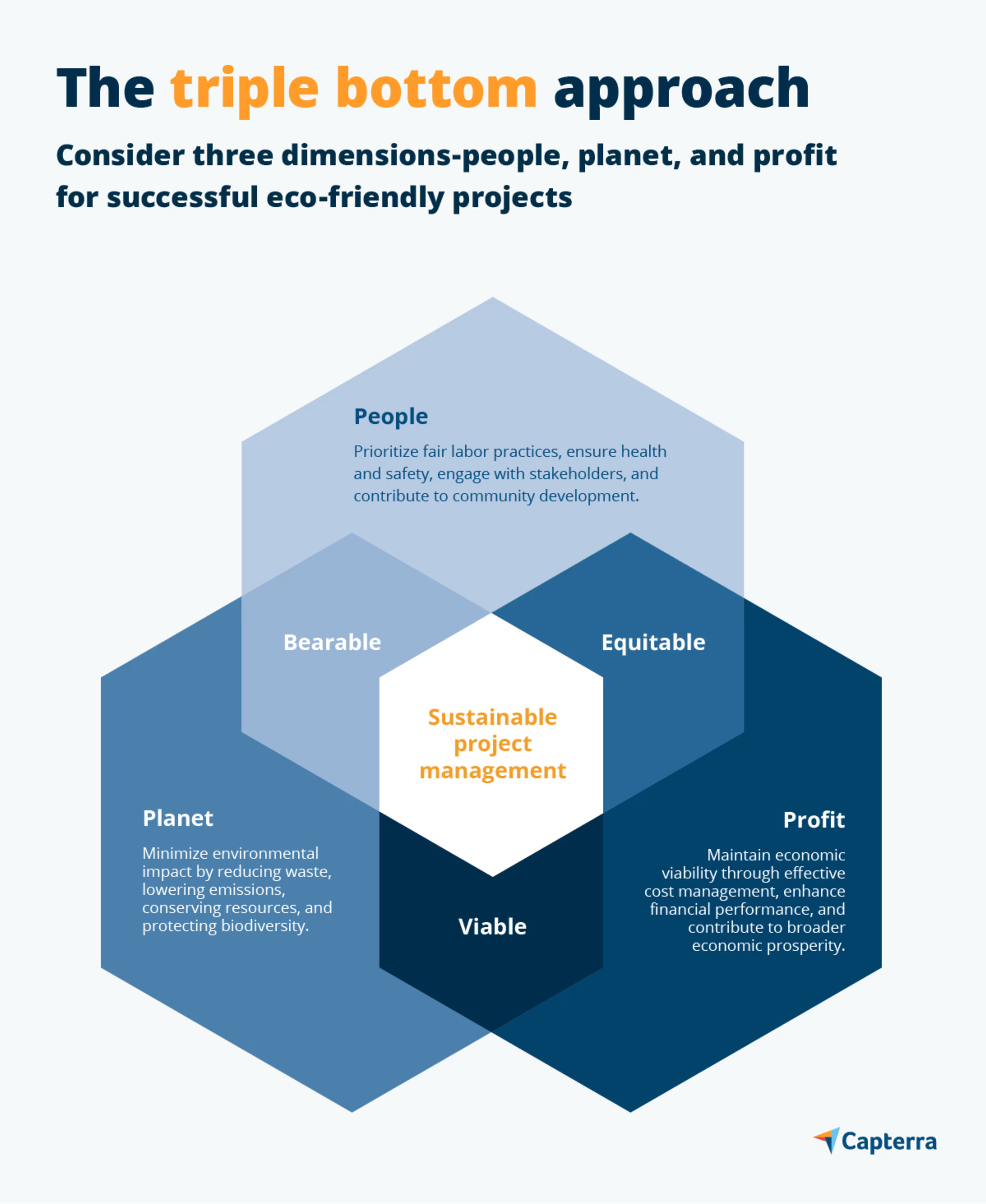Transform your project management approach for a more sustainable future.
The world is shifting toward green initiatives, with a whopping 76% of project managers highlighting the crucial role of sustainability in supply chain strategies.* But the benefits of sustainable project management extend far beyond logistics. It can boost project efficiency, reduce costs, and most importantly, contribute to a better environment. As people are becoming more eco-conscious, various industries are joining this green revolution.
We tapped into Elizabeth Harrin's[1] wisdom, a seasoned project manager and the force behind Rebel's Guide to Project Management (a go-to resource for project managers). She offers a fresh perspective on sustainability, viewing it not as an optional feature but as an integral part of a successful project lifecycle.
"Sustainable development means considering all aspects of sustainability throughout the project lifecycle, and it begins by selecting the right projects."


Elizabeth Harrin
Founder of Rebel's Guide To Project Management
What is sustainable project management?
Sustainable project management, aka green project management, integrates economic, environmental, and social factors in project execution. It encompasses long-term societal benefits such as job creation, health improvement, and social inclusion.
The approach addresses escalating global concerns about environmental degradation, resource scarcity, and social inequities. Though not universally adopted yet, the rising eco-consciousness, regulatory pressures, and stakeholder demands are increasingly prompting its consideration in all phases of the project.
Harrin says evaluating potential suppliers is her first step in ensuring her projects align with sustainability goals from the outset. She explains, “I don't just consider their costs or efficiency. I go with suppliers who have ISO14001 accreditationHarrin's approach to supplier evaluation applies across a wide range of project types, not just those requiring construction materials. It's equally relevant for smaller, office-based projects where suppliers might provide goods such as stationery, office equipment, or even software.
3 key sustainability considerations
The chosen sustainability considerations strike a right balance, combining economic viability with societal and environmental benefits. They advocate for long-term strategy, efficient resource use, and a three-pronged focus on people, planet, and profit, steering us toward a more sustainable future.
1. Triple bottom line (TBL) approach: A popular sustainability concept[2] that aims to balance three factors—People, Planet, and Profit (the 3Ps). Every project must be economically viable (Profit), socially beneficial (People), and environmentally friendly (Planet).

2. Long-term thinking: Sustainable project management emphasizes long-term strategic goals and outcomes. It aims to create projects that provide lasting value and do not harm the environment or society in the long run.
3. Resource efficiency: This means using resources sparingly and effectively, focusing on reducing waste and promoting recycling and reuse. The idea is to reduce the project's carbon footprint and environmental impact.
What are the benefits of integrating sustainability into project management?
In the evolving business landscape, integrating sustainability into project management isn't just a passing trend—it's a strategic advantage. It provides businesses a competitive edge over those who are yet to recognize and harness the power of sustainable practices. Here are some great benefits of integrating sustainability:
Boosts long-term viability
Sustainability helps you design projects with a forward-thinking mindset considering environmental, social, and economic changes. For instance, a construction project designed today with sustainable materials and energy-efficient technologies is more likely to meet future regulatory standards, societal expectations, and market demands. This long-term thinking helps ensure a project's relevance and success in an evolving, eco-conscious business landscape.
Amplifies profitability and efficiency
Sustainable practices involve reducing waste and optimizing resource use. This conserves the environment, cuts costs, and improves profitability. Plus, efficiency gains from better resource management can lead to shorter project cycles and higher-quality outputs.
Strengthens customer relationships
Sustainable project management plays a key role in strengthening customer relationships. Given that a significant 87% of consumers value sustainability in their purchases, projects embracing these principles naturally attract and retain such customers. Project managers can further this impact by recommending that marketing teams highlight the project's sustainability in their communications, fostering greater trust and loyalty among consumers.
Fortifies risk management
Environmental and social risks are becoming increasingly material to businesses. Sustainable project management considers these factors and helps businesses proactively identify and manage these risks.
For example, a tech company planning a new data center can use sustainability principles to address potential energy consumption and e-waste issues. This not only safeguards against potential regulatory penalties but also boosts the project's resilience and readiness for a greener future.
What are the challenges and possible solutions in implementing sustainable project management?
Despite its evident benefits, the journey toward sustainable project management isn't without hurdles. Let's explore the common challenges and find their solutions:
1. Difficulty in integrating sustainability into traditional project management processes
Integrating sustainability into established project management processes can be like trying to change the tires on a moving car—a challenging endeavor but not impossible. Traditional project management methodologies emphasize parameters such as time, cost, and scope, without considering environmental or social impacts. This can lead to resistance to adapting existing processes, hindering sustainable project management.
A practical solution to overcome this challenge?
Leverage project management software with sustainability features (like carbon footprint calculators, energy consumption estimators, waste management trackers, etc.) that can help track environmental impact, ensure compliance (adhering to environmental regulations and standards), and promote responsible resource utilization.
Couple your PM tool with sustainability software and environmental software solutions to measure your project's environmental footprint more in-depth and efficiently.
Adopt sustainability risk assessment strategies to foresee and tackle potential challenges proactively.
2. Insufficient understanding and skills for managing sustainable projects
This issue arises as traditional training often focuses on standard project management aspects—time, cost, scope—rather than sustainability. This creates a knowledge gap, limiting your ability to effectively incorporate sustainability into your projects, potentially impacting both project success and the organization's broader sustainability goals.
A practical solution to overcome this challenge?
Implement comprehensive training programs (including basic coverage like Triple Bottom Line, sustainability in project planning and execution, etc.), enhancing the team's knowledge of sustainable project management principles.
- Leverage PRiSM (Projects integrating Sustainable Methods) frameworkA methodology that helps you identify and manage environmental and social risks, measure the project's environmental footprint, and align project goals with sustainability objectives., specifically designed for sustainable project management, to guide processes and decisions. Harrin advocates for the PRiSM framework because “it guides you to consider pre and post-project impacts, broadening your view to encompass the asset's full lifecycle.”
Encourage continuous learning and development by encouraging team members to participate in seminars, workshops, and online courses to stay abreast of the latest sustainable practices and standards.
3. Resistance to change
Transitioning from traditional to sustainable project management can meet resistance within organizations due to the fear of disrupting familiar processes. This reluctance can slow down projects, compromise efficiency, and hinder compliance with evolving sustainability standards. Ultimately, this could put the organization at a competitive disadvantage in today's sustainability-focused business environment.
A practical solution to overcome this challenge?
Foster an organizational culture that embraces change and innovation.
Apply the Agile methodology, which supports iterative changes, allows for flexibility, and gradually eases the team into new sustainable practices.
Communicate effectively about the benefits of sustainable project management to alleviate concerns and promote acceptance.
Here's a video that explores the pros and cons of adopting sustainable project management more rigorously. Give it a quick look:
Project manager's role in making sustainable project management approach successful
Project managers play a pivotal role in championing sustainable project management. They strategically balance the triple bottom line:
People: They prioritize social value by promoting fair labor practices, diversity, and community development.
Planet: They consider environmental impacts, promoting resource efficiency, waste reduction, and eco-friendly practices.
Profit: They ensure economic viability, focusing on long-term gains over short-term profits.
Simultaneously, they work toward improving efficiency and effectiveness within this framework by implementing sustainability measures in project planning, execution, and control phases.
In our conversation, Elizabeth highlighted how project managers are now catalysts for sustainability, proactively embedding these principles before the project starts. She further added:
"It's not just about the project setup; it's about integrating sustainable practices into our day-to-day operations. For instance, we've minimized our carbon footprint by reducing in-person meetings for my remote team. We've also cut back on printing documents and started including environmental factors in our risk logs. It's these small changes that make a big difference."
Elizabeth Harrin
Action plan to set the wheels in motion!
As we look ahead, sustainable project management is becoming a vital element in ensuring the future viability of businesses amidst growing environmental concerns. This shift also aligns with the evolving expectations of stakeholders, considering sustainability in their decision-making processes.
Based on Elizabeth's insights, here's a simple action plan to set the wheels in motion:
Modify business case templates: Add a section in your business case template or project request form that prompts stakeholders to consider sustainability and the triple bottom line.
Link to sustainability strategy: Connect projects to your organization's objectives. This embeds sustainability into the project's purpose from the start.
Reevaluate supply chain practices: Integrate sustainable practices into your supply chain management. Make conscious choices about the vendors you partner with, factoring in their sustainability practices.
These steps can help you shape a future where projects' success and sustainability go hand in hand.
